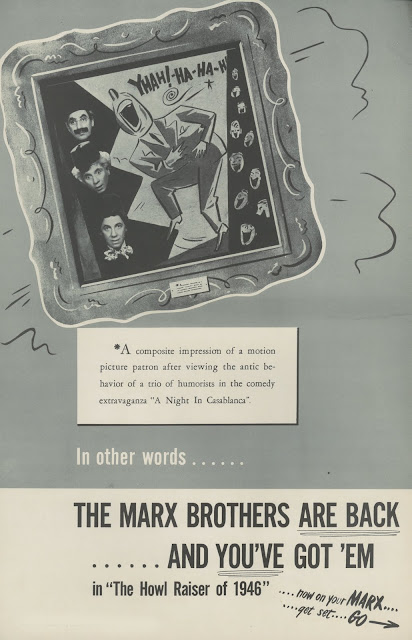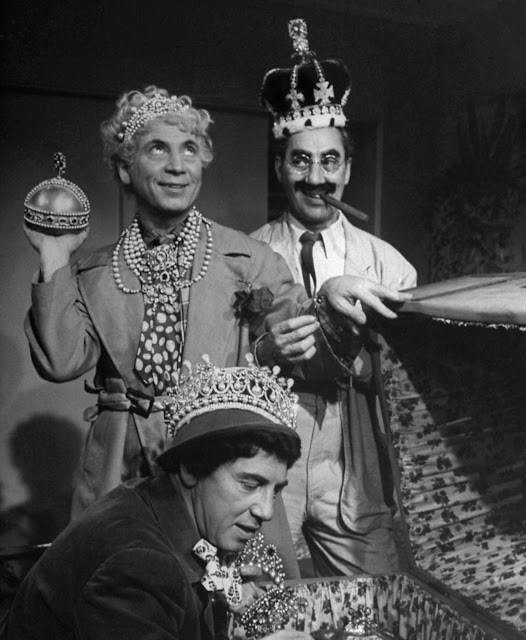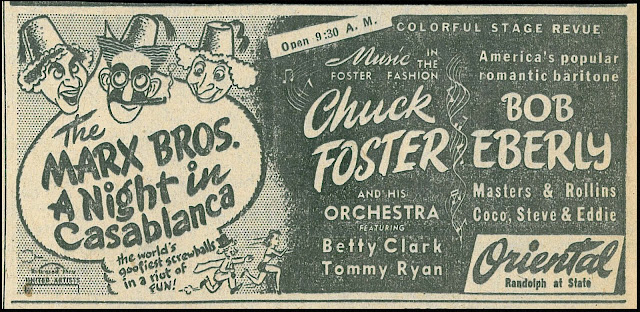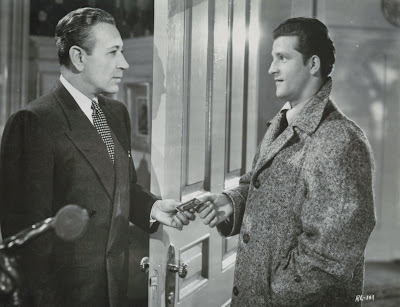Favorites List --- Vera Cruz --- Part One


I reckon Vera Cruz to have been the first brute western. Not for nothing was it an enormous commercial hit. Meanness, if not actual violence, was up-ticked in what's understood to have been a hodgepodge shot barely ahead of script pages being typed. Who looked ahead from baking Mexico locations in 1954 to a decade later when attitudes forged on Vera Cruz would dominate nearly all westerns, Euro and eventually stateside ones? Here was a showdown between white and black-hats where a jading public began its drift toward the latter. We'd been tempted before to choose badness in personage of Gregory Peck's lawless Lewt of Selznick's Duel In The Sun, a whopper success that proposed wrong being more fun than right. Guess it's safe to say there wouldn't have been a Vera Cruz before the war. Ruthless means of getting a job done was now understood if not embraced. Burt Lancaster stood for those tired of protags who'd shoot guns out of hands (as Gary Cooper does) rather than going for throats (where Burt gleefully applies his lance). Was Cooper conscious of fact he'd defend a persona fast turning obsolete? From what's been written of set differences, I'd say Coop, consciously or not, made the last stand on behalf of cowboys who'd always been heroes, but whose days as such were numbered if not over.
 |
| Just Pals Off-Screen --- Though Cooper Would Balk at Aldrich and Burt Directing Him. |
Lancaster was more than feeling oats by time they'd got below borders to shoot Vera Cruz in March 1954. He'd been shot out of a cannon that was From Here To Eternity and recently embarked on remaking an industry in his flamboyant image. Whatever twist on a western he chose saw no barrier to financing. In this case, it was United Artists that would kick in and bow besides to minimal distribution fees just for privilege of handling Burt's independent output. Everything he touched (for now) turned to coin. Lancaster was adjudged a force of nature other actors might better steer wide of, Gary Cooper being advised by friend (and friendly rival) Clark Gable to avoid Vera Cruz, but terms Burt's company and UA tendered held promise of riches such as Coop hadn't known in years of dung-kicking on Paramount and (lately) Warner backlots.
 |
| Coop's Either Dabbing Make-Up or Signaling Rescuers To Get Him Off VC's Hell-Hot Location. |
Lancaster had just done a glum western called Apache with a young director he liked well enough to invite along on Vera Cruz. This would be Robert Aldrich's first big-$ venture ... $1.5 million to spend, but all aboard knowing they'd get twice its value by way of cheap labor and accommodations. Just as soldiers of fortune descend on Mexico under Vera Cruz credits, so did Hecht (Harold, BL's producing partner)-Lancaster trucks hauling equipment into arid locations off paths beaten even by Hollywood-ites lately there to do Blowing Wild, Garden Of Evil, and other pics lensed Mexico-way. Gary Cooper had in fact top-lined those last two --- becoming near as expatriated as Vera Cruz alter-ego Ben Trane --- but tax furlough Coop sought could be had only by living and working outside the US for extended period, thus his screen characters taking up what seemed permanent residence below the border.
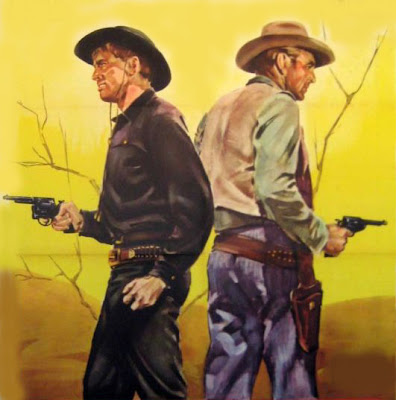
Warner Bros. had counted on Vera Cruz filling their release chart from announcements made in April 1953, but it now seemed an (From Here To) eternity since Lancaster's willingness to accept terms dictated by oblivious-to-his-value WB. The star now at a peak of negotiating power took marbles to United Artists and by October had partner Harold Hecht dickering with 20th Fox for license of their Cinemascope process for Vera Cruz. That wouldn't transpire, and neither would a same month's start on the Mexican shoot, Apache moving up to first among Hecht-Lancaster's UA pledged pics.

Gary Cooper's casting made Vera Cruz a two-act buddy show with slide-rules applied to give each star prominence due. Ben Trane didn't come to Mexico just for the ride, as he tells another of VC's characters, and neither did a Cooper protective of his image and star status --- this was a script daily parsed to head off top-dogging by either man. Appropriate then that Vera Cruz found Coop's Ben and Lancaster's Joe Erin wary of each other throughout, both alert to possibilities of a double-cross. Director Aldrich got a preview here of big-name circling he'd referee later with Baby Jane's mutually suspicious pair, Bette Davis and Joan Crawford. Cooper's on-set underplaying convinced Lancaster he'd chosen a lethargic partner ... till rushes told a different story. That had only happened a few hundred times to others who underestimated Coop's screen presence.

There had been buddy/rival teamings before. Clark Gable and Spencer Tracy, Cagney/O'Brien ... the latter double-dealt at least as ferociously in 1940's Torrid Zone, and that was in wake of service actioners where neither could trust the other. Bob Hope and Bing Crosby upped levels of rapacity in comedies right up to Vera Cruz's doorstep. It isn't hard imagining VC played for laughs with Bob/Bing angling for gold and gals. What shocks (or did in 1954) is Lancaster adding casual kills to Joe Erin's portfolio, and making it funny enough in his circus manner (Joe is another Crimson Pirate --- only more bloodthirsty) to suspend patron's moral judgment. No wonder Burt suggested letting Joe Erin survive Vera Cruz's fade, till Gary Cooper stepped up and said Nope.
 |
| Mari Blanchard Welcomed Abbott and Costello to Mars, But Her Big Vera Cruz Break Would Stall on Take-Off. |
The women of Vera Cruz amount to little more than that puff of smoke Caesar Romero references early in the show. There was never intent to get major distaff names. Mamie Van Doren applied, and based on casting criteria, might have been taken up. Another Universal-International starlet, Mari Blanchard, was in fact green lit for Vera Cruz. Her big break, said Hecht-Lancaster and trades, the latter which quoted Mari regarding her key scene in Vera Cruz, a rain-barrel tête-à-tête with Gary Cooper where she definitely will wear nothing but her birthday suit, according to Variety's Vernon Scott. Anything goes across the border, after all. Why else would so many gringos choose Tijuana for weekend getaways? (So Foreign ... Yet So Near, per the 1953 travel ad below).


We forget much of failure in life, Hollywood's being perhaps fastest obscured. Mari Blanchard you'd barely recall now, but it might not have been so had luck dealt the Vera Cruz gig Mari eagerly packed for. In fact, it was mere hours short of departure to Mexico when word came she'd lost the part. A last minute contract dispute between Hecht-Lancaster and loaning Universal seemed picayune, but Mari's prospects hung upon it, her disappointment over the loss profound. All the more galling was learning of the switch not from home lot U-I. but columnist Harrison Carroll, who'd gotten it off AP's wire. Denise Darcel took Blanchard's job, and placement in the rain barrel, a sequence that for all anticipation leading up to it, was ultimately dropped from Vera Cruz.
 |
| Shades of Gable and Harlow in Red Dust! --- But This Notorious Rain Barrel Sequence with Coop and Denise Darcel Wouldn't Make It Into Final Prints of Vera Cruz. |
 |
| United Artists Sold Sarita Montiel as Naughty, but Coop Found Her Plain Dirty --- So It Was Unaccustomed Hands-Off Throughout VC's Shooting. |
 |
| Slapped Silly Just Before the Clinch --- Is This How Yanks Figured French Wantons Went About Their Lovemaking? |
What this western needed was Bombshells to play off Coop and Burt. Never mind that Darcel and Sarita Montiel couldn't act their way out of bags. Success of Euro art flicks fed perception that imported exotics played better games of love. Photogs winged south for art on Vera Cruz's bevy of beauty and word came back that much of what they shot was too hot to publish. Director Aldrich barely got English dialogue out of Montiel, Cooper all too clearly struggling through VC exchanges with her. Darcel tries teaching Burt's Joe Erin a French style of seduction, but comes off coarse in a slap(s) and kiss exchange likely as off-putting in 1954 as now. If Vera Cruz had been made just a few years later, I'm guessing there'd have been a Playboy spread devoted to what press reps dubbed its feminine spice.
Part Two of Vera Cruz is HERE.



































